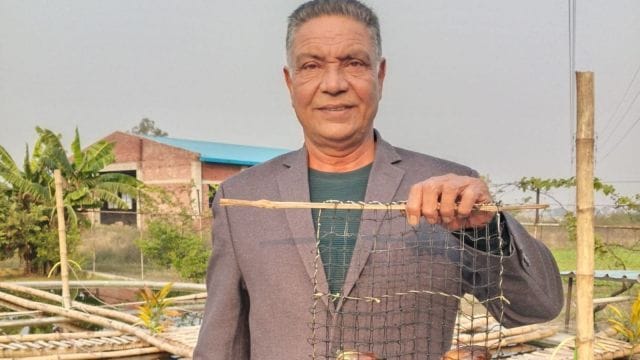In Patiala a hidden Gem: An Oyster farm that earns its owner Rs 50L profit from just a quarter acre
He was also granted the Chief Minister’s Award for his goat farm. After spending over 20 years in Canada working in real estate, he returned to India in 2019 when his father fell ill. He decided to stay and start some business here and then he began with goat farming over four years ago.
 Over the past few years, Sunny Kang (60), has transformed his five-acre family farm into an innovation hub by rearing goats and growing organic crops. (Express Photo)
Over the past few years, Sunny Kang (60), has transformed his five-acre family farm into an innovation hub by rearing goats and growing organic crops. (Express Photo)A small farmer entrepreneur has managed to create an agricultural shift in the village of Baran on the outskirts of Patiala.
The Canada-returned NRI has introduced pearl farming, a concept unfamiliar to most farmers in Punjab, — a sector he believes holds immense potential for India.
Over the past few years, Sunny Kang (60), has transformed his five-acre family farm into an innovation hub by rearing goats and growing organic crops. An MA Economics and MBA graduate, he began agriculture four years ago with 14 goats. He now has a total of 200 Beetal goats and Muzaffarbadi sheep, earning him millions annually.
He was also granted the Chief Minister’s Award for his goat farm. After spending over 20 years in Canada working in real estate, he returned to India in 2019 when his father fell ill. He decided to stay and start some business here and then he began with goat farming over four years ago.
Initially, while researching goat farming technologies online, he came across pearls. What pushed him further to explore is his discovery — India, being one of the world’s largest consumers, imports pearls worth thousands of crores of rupees annually.
He learned about a method gaining global traction — pearls are not only harvested in marine water but can also be cultivated in freshwater.
Sunny visited Japan, two years ago, to learn freshwater pearl cultivation and the science of nucleation, inspired by the country’s farmers.
He explains that naturally, an oyster forms a pearl when an irritant enters its shell and then the oyster secretes nacre, which coats the irritant and many layers of it forms a smooth pearl. Traditionally, oysters were killed to retrieve pearls and the success rate was poor, but Japanese researchers revolutionised the process by surgically inserting a nucleus, an irritant, so the pearl forms around it, producing highly desirable cultured pearls.
On coming back, he procured 100 freshwater oysters from Gujarat and Hyderabad about 1.5 years ago. He focused on two Indian freshwater oyster species — L corrianus (produces silver, white and silver-white pearls) and L marginalis (produces golden and light golden pearls).
Sunny says that pearl farming even in 1,000 sq yards (¼ acre) can generate Rs 70–72 lakh in revenue with about Rs 50 lakh profit. He admitted that prices can go much higher with superior quality pearls.
These oyster species can also produce rare colours such as lavender, pink, peacock, blue and green, depending on nacre quality. After procurement, oysters undergo a seven to eight days adaptation period in a separate unit to adjust to new water and food.
Once their health is confirmed, nuclei are inserted: the oyster is opened with a mouth opener, the nucleus placed with a spatula and the oysters kept in ICU trays with antibiotics. Later, they are moved to small drums for light feeding.
 Sunny visited Japan, two years ago, to learn freshwater pearl cultivation and the science of nucleation, inspired by the country’s farmers. (Express Photo)
Sunny visited Japan, two years ago, to learn freshwater pearl cultivation and the science of nucleation, inspired by the country’s farmers. (Express Photo)
After feeding the oysters for the next 15 days, Sunny shifts them to 10×10 ft ponds, housed in fish nets. They are stored with a pH of 6.5 to 7, and water quality maintained up to TDS 500 (not above 700). In case the TDS is high, stored rainwater is added.
Seeing good results within three months, Sunny expanded to 5,000 oysters across 10 10×10 feet ponds (500 oyster per pond).
Monitoring is done daily for a month, twice a week for the second month, twice a month after that and later once every two months — checking TDS, pH and mortality. If an oyster dies naturally, the partly formed pearl (nucleus) is reused in a new oyster.
“While oyster mortality in India is 30 to 40 per cent, with Japanese techniques my farm maintains 9 to 10 per cent. Pond water requires no replacement for 1.5 years as each oyster filters 150–200 litres daily,” said Kang.
India usually produces two pearls per oyster, Japan eight to nine; Sunny aims for four pearls per oyster. Oysters typically die after producing pearls since their lifespan is five to seven years, and by harvesting age they are already four to five years old.
Food remains critical: he uses organic market feed and imports high-quality, pure-pearl Japanese nuclei, which are costlier but superior.
“The freshwater pearl market is expanding fast, valued at $13.7 billion globally and projected to reach $34 billion by 2034. In India, designer pearls dominate.”
According to Kang, advances in freshwater pearl farming could help India enter the high-end cultured pearl segment.
Sunny noted that quality pearls fetch extremely high prices. “The world’s largest natural pearl valued at more than $140 million featured in a Filipino Canadian artist’s debut exhibit in Toronto,” Sunny said. It is the largest of its kind and belongs to Toronto based artist Abraham Reyes.
Pearl formation takes two to two-and-half years; his oysters have completed one-and-half years. He expects his first major harvest in eight months. With accounting for a 10 per cent mortality rate, he will get about 18,000 pearls from 5,000 oysters. He has also created a cycle to harvest 500 to 1,000 pearls every four months.
After promising sample results, Sunny has begun training other farmers — mainly NRIs, doctors and engineers — at his Nova Pearl Farm in Patiala, promoting eco-friendly methods like organic algae feed and mineral supplements.
His programmes combine theory with hands-on experience in freshwater pearl farming and organic agriculture. He said the Indian government is also promoting pearl cultivation through initiatives like Pradhan Mantri Matsya Sampada Yojana, but it is still not popular in Punjab.
He advises to start with a small project, and after gaining proper knowledge and experience, increase the oysters and make a proper cycle for a regular income.
Pearl farming is “technical but easy”, requiring little space, Sunny says. The 2.5-year cost per oyster is Rs 470: Rs 12 for the oyster, Rs 400 for nuclei and Rs 52 for feed and medicines. Cultured pearls sell for Rs 350 – Rs 400 minimum, with premium pearls fetching far more. Using his method, farmers can earn about Rs 1,400 per oyster, and selling 1,000 pearls every four months yields nearly Rs 4 lakh on a Rs 1.2 lakh investment — around 70 per cent minimum profit.
Pearls have strong demand in jewellery, medicine, cosmetics and astrology, he says, adding that proper feeding, and maintaining optimal TDS and pH can result in better lustre, size and shape.
Only a few people in India currently farm pearls at scale and knowledge-sharing is rare, but Sunny believes even thousands of new farmers wouldn’t meet existing demand. He earns more now — through goats, pearls and organic vegetables — than he did in Canada. Instead of mandis, he sells directly to buyers, and also focuses on farming and training to help small farmers profit. He urges youth to pursue such opportunities.
With a capacity to produce 18000 to 20,000 pearls from his oyster farm, Sunny has plans to expand even further. “This is just the beginning. The future of pearl farming in India is bright, and I want to be a part of that future,” Sunny said, with the confidence of someone who has turned a dream into reality.







